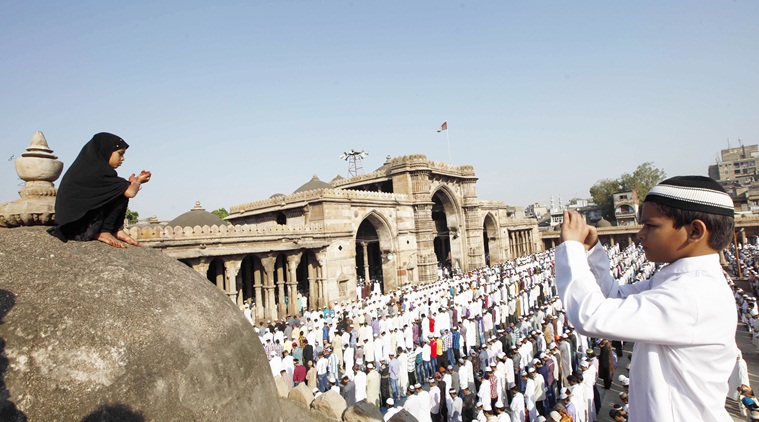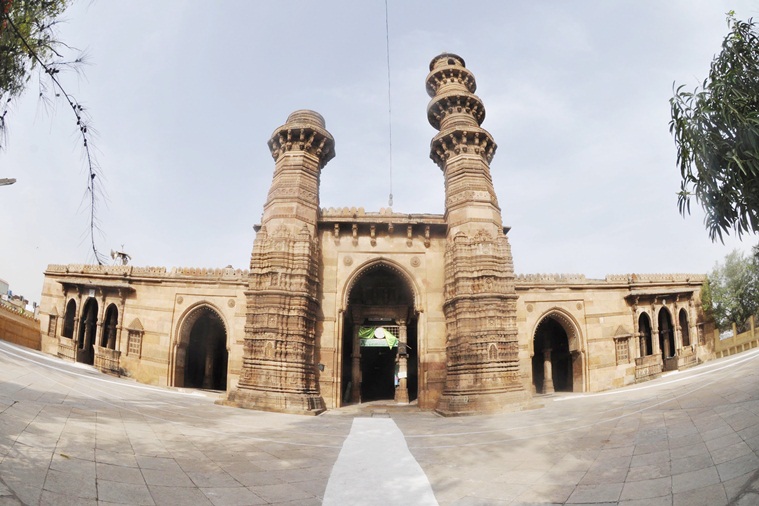
The Ahmedabad Municipal Corporation’s Heritage Walk begins at the Swaminarayan temple in Kalupur. You gather in the early morning in the large open courtyard, flanked on three sides by multi-storeyed haveli buildings. This temple is very different from the elaborate marble temples associated with the sect. Devotees go about their business and pigeons flutter in droves, as the knot of motley tourists heads out into the narrow lanes of Ahmedabad’s old city.
The walk meanders through the pols, a form of high-density living accompanied by a highly organised social structure, which is a distinctive and defining feature of the city. There are an estimated 365 pols, accommodating a further 600 sub-pols. A pol comprises a cluster or several clusters of tightly-packed houses connected by an internal network of labyrinthine lanes and fronted by a gate. This form of community living is said to have emerged after the 15th century, possibly to counter the harsh summer heat and also to provide protection from Maratha raids in the 18th century. Cows lumber past in the chowks where a propped-up blackboard might announce the latest news or a community feast. You pass wooden facades, ancient water tanks, Jain temples and ornate birdfeeders.
Ahmedabad, the capital city of Gujarat, was founded on the banks of the Sabarmati in 1411 by Ahmed Shah, direct heir to his grandfather, Muzaffar Shah, who broke away from Delhi rule after Timurlane’s invasion, to form the Gujarat Sultanate. The Heritage Walk takes you to the Sultanate-era tombs and mosques, including the magnificent Jami Masjid, evocatively described by John Burton-Page as a “harmony of solids and voids”. The last stop is the bustling market, Manek Chowk, where stands a 115-year-old building which housed the country’s second-oldest stock exchange.
The building of a railway and the establishment of commercial enterprises in the 19th century changed the socio-cultural and economic parameters of the old city. Over time, people left to live in modern colonies in the newly-expanded city. The old city declined and a real-estate cartel moved in, seeking to demolish old houses and build anew. Parts of houses like jharokhas and doors were stripped and sold in antique markets in other parts of the country.
 The Jhulta Minara in Ahmedabad. (Express photo by Javed Raja)
The Jhulta Minara in Ahmedabad. (Express photo by Javed Raja)
The reimagining of the old city began gradually in the late ’90s, with the percolation of Western-inspired ideas of heritage conservation. These influences can be seen in the preserved facades of landmarks, identified by small, neat plaques, in statues in lifelike poses, that turn public squares into exhibition tableaux. The effort snowballed through the 2000s, involving stepped-up conservation activity and local communities — artists, photographers, dancers, students, including those at the city’s premier design and architecture institutions, quasi-historians and the media, culminating in a quest beginning around 2010 to be listed by Unesco as a World Heritage City.
The listing of Ahmedabad as a World Heritage City by Unesco this month — India’s first — can then be seen as a welcome move. One cannot argue with the need to protect historical monuments and cultural artefacts from wanton destruction. Nor is there any doubt about the merits of Ahmedabad’s unique and fascinating history. However, the announcement also raises some concerns.
The first is over the representation of history. In recent years, revisionist historians have attempted to urge different versions of Ahmedabad’s history. For instance, in 1987, when the BJP came to power in the Ahmedabad Municipal Corporation, it mooted the proposal to change the name of the city to Karnavati on the basis of a claim that Ahmedabad had come up on the site of a town built by the Hindu Solankis called Karnavati. Historians are not clear if Karnavati existed and, if it did, whether it was a town or a military outpost. It is also likely that a tribal settlement called Ashavali existed in the vicinity.
Then, there is the story of how a weaving master from Ahmedabad made an offer at the 1905 Congress session in Benaras to train Bengali youths in cloth-making if they would teach Gujaratis how to make bombs. A group of revolutionaries from Bengal turned up. In 1909, a bomb was thrown by a Gujarati, Mohanlal Pandya, on the Indian viceroy and his wife, Lord and Lady Minto, in Ahmedabad. The Mintos escaped unhurt.
 The Swaminarayan temple. (Express photo by Javed Raja)
The Swaminarayan temple. (Express photo by Javed Raja)
The house where the Bengali youths stayed, called ‘United Bengal Home’ in Dhobi-ni-pol, is the centrepiece of a Freedom Walk in the old city — as well of a narrative that claims a militant projection of Gujarat’s involvement in the freedom struggle, which varies with the more conventional narrative of Gandhi’s non-violent struggle. The Unesco listing, then, raises questions about historical veracity in conservation and who gets to decide which version is to be privileged.
The other concern lies in the ways in which a focus on conservation can be leveraged to neglect contemporary problems. The marketing of local heritage has become a tool used to attract tourists and investors seeking an exotic experience. In the 1980s and 1990s, Shanghai, for instance, restored its traditional shikumen (stone-gate houses) in the narrow alleys of the district of Xintiandi. Singapore focused on the conservation of its colourful ethnic quarters such as Chinatown and Little India. But, as urban scholars acknowledge, “cultural imagineering”, as this form of urban engineering is called, has the potential to conceal social complexities and polarisations of various kinds — ethnic, gender, social and so on — by “mobilising every aesthetic power of illusion and image”.
In 2007, at a time when Gujarat was under harsh criticism, nationally and internationally, for the anti-Muslim violence of 2002, a Brazilian dancer dancing amidst the rubble in the old city sensitised Ahmedabadis to the pain of their destroyed heritage. The language of the heritage movement, terms and phrases such as “conservation”, “restoration”, “revitalisation”, “revival of Ahmedabad’s pride”, seemed designed to bring solace to a city under attack. By displacing both shame and solace to the plight of a building or a bird feeder and by making possible the reclamation of the Islamic, as poetry, architecture and craft, but not as a community or a religion, the heritage movement seemed to consciously or unconsciously play into a pro-majoritarian agenda.
Despite these concerns, one is tempted to see an opportunity in the declaration of Ahmedabad as a World Heritage City for a renewed interest by citizens in their own past. Reading about Ahmedabad’s old city, I have always been struck by the involvement of its citizens in shaping the city. And, if I were to propose a more freewheeling walk through the old city, I would suggest starting at Lal Darwaza.
A peek into former mayor Sardar Patel’s city home could remind one of the fervid late 19th and early 20th century debates between local industrialists and professionals on the future of the city, and how one sheth actually wrote to Florence Nightingale, seeking her opinion on a new sanitation measure. Memorials in the vicinity might recall the Mahagujarat agitation of the 1950s, and the sacrifices made by Hindu and Muslim youths for an independent state. One might come across a statue of the charismatic Mahagujarat leader and friend of the common man, Indulal Yagnik. Then, one could stop at the office of Majoor Mahajan, the textile workers’ union established by the sister of a local textile magnate, which played an important role in shaping free India’s labour policies.
And that could be, perhaps, just a beginning in rediscovering the culture of a remarkable city.
The writer is the author of Ahmedabad: A City in the World.
[“source-indianexpress”]
















